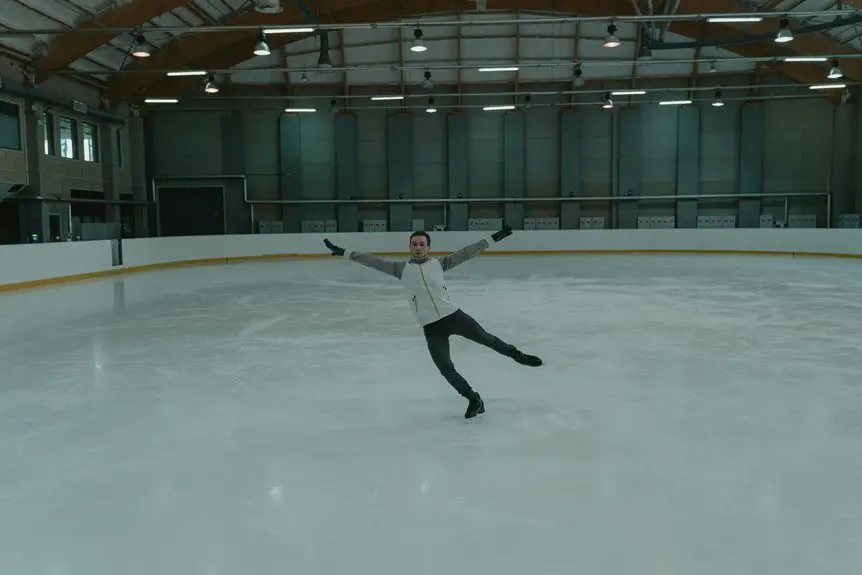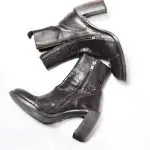You want to stay cool, dry, and comfortable during your workout. You want your gear to work with your body, not against it. Moisture-wicking fabrics do just that by pulling sweat away from your skin and speeding up evaporation. But how exactly does this technology affect your performance and comfort? Understanding this can change the way you choose your athletic wear and improve your exercise experience.
Table of Contents
Key Takeaways
- Moisture-wicking fabrics quickly pull sweat away from skin, keeping athletes dry and comfortable during intense exercise.
- Efficient sweat evaporation prevents overheating and sticky, uncomfortable sensations, enhancing overall cooling and freshness.
- By reducing sweat buildup, moisture-wicking clothing helps maintain ideal body temperature and prevents clammy feelings.
- Staying dry and cool minimizes fatigue, allowing athletes to perform longer and maintain focus during workouts.
- Advanced fabric technologies improve breathability and moisture management, reducing chafing and irritation for better comfort.
How Moisture-Wicking Fabrics Regulate Body Temperature
When you wear moisture-wicking fabrics during exercise, they pull sweat away from your skin and spread it across the fabric’s surface, where it evaporates quickly.
Moisture-wicking fabrics draw sweat from your skin, spreading it out to evaporate swiftly for better comfort.
This process plays a crucial role in temperature regulation by preventing sweat from pooling on your skin, which can make you feel cold or clammy.
Thanks to the enhanced fabric breathability, air circulates freely, helping to cool your body more efficiently.
You’ll notice that moisture-wicking materials keep your skin dry and comfortable, allowing your body to maintain an ideal temperature even during intense workouts.
The Role of Sweat Evaporation in Cooling and Comfort
Because sweat evaporation directly cools your skin, it plays an indispensable role in keeping you comfortable during exercise.
When you sweat, your body releases moisture onto your skin’s surface. As this moisture evaporates, it absorbs heat from your skin, lowering your body temperature. This natural cooling mechanism helps prevent overheating and keeps you feeling fresh.
Your clothing impacts how efficiently sweat evaporation happens; moisture-wicking fabrics pull sweat away from your skin, speeding up evaporation. Without this process, sweat would just sit on your skin, making you feel sticky and uncomfortable.
Understanding these cooling mechanisms helps you appreciate why moisture management is crucial for comfort during workouts. It’s not just about sweat—it’s about how your body cools itself effectively.
Impact of Moisture-Wicking on Physical Performance and Fatigue
Although moisture-wicking fabrics don’t directly boost your strength or speed, they play an essential role in sustaining your physical performance by managing sweat and reducing fatigue.
When sweat is efficiently pulled away from your skin, your body stays cooler and more comfortable. This prevents overheating and the heavy, clingy feeling that can slow you down.
By keeping you dry, moisture-wicking gear supports fatigue reduction, letting you push harder and longer during workouts or competitions. This comfort translates into performance enhancement because you won’t be distracted by discomfort or slowed by damp clothing.
Ultimately, choosing moisture-wicking apparel helps you maintain focus and energy, so you can perform at your best without the drag of sweat weighing you down.
Fabric Technologies Behind Effective Moisture Management
You’ll notice that fabric technology plays a huge role in how well moisture is managed during your workouts.
Understanding capillary action, the difference between synthetic and cotton materials, and fabric composition will help you pick gear that keeps you dry and comfortable.
Let’s explore how these factors work together to boost your athletic performance.
Capillary Action Mechanism
Capillary action plays an essential role in how moisture-wicking fabrics keep you dry during intense workouts. This natural phenomenon enables liquid transport through tiny fabric fibers, pulling sweat away from your skin to the outer surface where it evaporates quickly. You benefit from improved comfort and reduced chafing thanks to this constant moisture movement.
| Fabric Type | Capillary Action Efficiency | Liquid Transport Speed |
|---|---|---|
| Microfiber | High | Fast |
| Merino Wool | Moderate | Moderate |
| Polyester Blend | High | Very Fast |
Understanding capillary action helps you choose gear that moves sweat efficiently, keeping you cooler and more comfortable during your toughest sessions.
Synthetic vs. Cotton
When you compare synthetic fabrics to cotton, you’ll notice they handle moisture very differently.
Synthetic fabrics offer clear synthetic advantages: they pull sweat away from your skin, drying quickly and keeping you comfortable during intense workouts. These fabrics promote breathability and reduce chafing, which helps maintain your performance level.
On the other hand, cotton has notable cotton drawbacks. It absorbs moisture but holds onto it, making the fabric heavy and damp. This leads to discomfort, skin irritation, and even chills when you cool down.
Cotton’s slow drying time means sweat lingers, increasing the risk of blisters and rashes.
Fabric Composition Impact
Although choosing the right fabric type matters, understanding the specific technologies behind moisture-wicking materials can help you make smarter athletic wear decisions.
Different fabric types like polyester, nylon, and blends are engineered to pull sweat away from your skin, reducing moisture retention. These fabrics often feature microfibers or special weaves that increase surface area, speeding up evaporation.
Some incorporate hydrophobic treatments to repel water, keeping you dry and comfortable during intense workouts. When you pick athletic clothing, look beyond basic fabric labels and focus on these advanced moisture management technologies.
They guarantee sweat doesn’t linger, preventing chafing and overheating. By choosing fabrics designed with moisture-wicking tech, you’ll stay cooler, drier, and perform better, no matter how hard you push yourself.
Benefits of Moisture-Wicking Clothing in Various Exercise Conditions
Since your body generates sweat during exercise, moisture-wicking clothing helps keep you dry by pulling sweat away from your skin to the fabric’s surface, where it evaporates quickly.
This feature proves invaluable across different exercise environments and temperature variations.
When you wear moisture-wicking gear, you’ll notice:
- Enhanced comfort by staying dry and cool in hot conditions
- Reduced chafing and irritation during intense workouts
- Better temperature regulation whether indoors or outdoors
- Faster drying times after water-based activities or rain
- Improved focus and endurance, thanks to consistent dryness
Consumer Insights and Market Trends Surrounding Moisture-Wicking Apparel
You’ve probably noticed how moisture-wicking apparel is booming, driven by growing fitness trends and tech advances.
Athletes today not only want performance but also style, blending fashion with function.
Let’s explore what’s shaping consumer choices and how this trend continues to evolve.
Market Growth Drivers
As more people embrace active lifestyles, the demand for moisture-wicking apparel keeps rising. This growth is fueled by shifting consumer preferences and increasing market demand for comfortable, performance-enhancing clothing.
You’ll notice brands responding quickly to these trends, offering innovative fabrics and designs tailored to your needs. Key market growth drivers include:
- Rising awareness of moisture management benefits
- Increased participation in fitness and outdoor activities
- Desire for quick-drying, breathable materials
- Expansion of athleisure fashion blending style with function
- Advancements in textile technology improving fabric performance
Athlete Perception Trends
How do athletes really feel about moisture-wicking apparel? Your preferences often lean toward gear that enhances comfort and performance. Athletes consistently provide positive performance feedback, highlighting moisture-wicking fabrics as essential for staying dry and focused during workouts and competitions. This trend reflects a growing demand for athletic wear that supports endurance and recovery.
| Athlete Preferences | Performance Feedback |
|---|---|
| Prioritize breathability | Report less overheating |
| Favor lightweight fabrics | Notice quicker sweat evaporation |
| Seek durability | Experience improved comfort |
Fashion Meets Function
While moisture-wicking technology started as a performance feature, it’s now a key driver in fashion trends and consumer choices.
You’ll notice brands blending style innovation with performance enhancement to create apparel that looks as good as it performs. This shift means you don’t have to sacrifice comfort or function for fashion anymore.
Here’s why moisture-wicking gear is dominating the market:
- Keeps you dry and comfortable during workouts and daily wear
- Offers sleek, modern designs that fit both gym and casual settings
- Uses advanced fabrics that adapt to your body temperature
- Supports active lifestyles with breathable, lightweight materials
- Reflects growing consumer demand for versatile, functional fashion
Frequently Asked Questions
How Do Moisture-Wicking Fabrics Compare to Traditional Cotton in Durability?
When you compare durability, moisture-wicking fabrics usually outperform traditional cotton. Their fabric longevity resists wear and tear better, so you won’t have to replace them as often, making them a smarter choice for active use.
Can Moisture-Wicking Clothing Help Prevent Skin Infections During Workouts?
Think of moisture-wicking clothes as your workout’s shield; just like a raincoat keeps you dry, they reduce skin irritation by pulling sweat away, helping you prevent infections and stay comfortable during intense exercise sessions.
Are There Specific Care Instructions to Maintain Moisture-Wicking Properties?
You should follow proper fabric maintenance by washing moisture-wicking clothes in cold water and avoiding fabric softeners. These washing techniques help preserve the fabric’s performance, keeping its moisture-wicking properties effective for longer.
Do Moisture-Wicking Fabrics Affect Clothing Odor After Prolonged Use?
You’ll notice moisture-wicking fabrics help with odor prevention by keeping sweat away from your skin. Their fabric breathability lets air circulate, reducing bacteria buildup that causes smells, so your clothes stay fresher longer after prolonged use.
Are Moisture-Wicking Clothes Suitable for All Weather Conditions Year-Round?
You’ll find moisture-wicking clothes offer great seasonal versatility, keeping you dry and comfortable in various weather. Their fabric breathability helps regulate temperature, making them suitable for year-round use, whether it’s hot summer or chilly winter.







